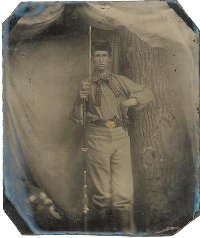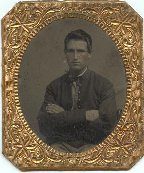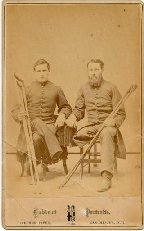Special Feature: A Civil War Antiques Story
An important antique discovery has taken place. Although records indicate thousands of unique "green" uniform coats were issued and worn by two distinguished Union regiments know as Berdan's Sharpshooters, only a single known specimen housed in the Smithsonian Institution has survived to modern times. Now, there are two. This story involves a forgotten wayfaring Union soldier named William Tilson and a wealthy inventor turned colonel, Hiram Berdan.
 Bill's Story:5' 11" tall William F. Tilson was 16 years old, November 9, 1861, when he tried out for Company E, of the 2nd Regiment, United States Sharpshooters. A Vermont farmer, he must have spent long hours practicing his shooting. To become a "U.S." Sharpshooter, the only volunteer unit to bear such a designation, Bill was required to fire his own non-scope rifle ten consecutive rounds, reloading fast as possible, at one of two targets. The first being 200 yards distant while using a rest, the other paced at 100 yards that was fired at offhand. Any contestant missing the targets or averaging more than five inches from center was disqualified. Bill made the company.
Bill's Story:5' 11" tall William F. Tilson was 16 years old, November 9, 1861, when he tried out for Company E, of the 2nd Regiment, United States Sharpshooters. A Vermont farmer, he must have spent long hours practicing his shooting. To become a "U.S." Sharpshooter, the only volunteer unit to bear such a designation, Bill was required to fire his own non-scope rifle ten consecutive rounds, reloading fast as possible, at one of two targets. The first being 200 yards distant while using a rest, the other paced at 100 yards that was fired at offhand. Any contestant missing the targets or averaging more than five inches from center was disqualified. Bill made the company.
He was issued a bayonet-fitted, Model 1859; double set trigger, Sharps.52 caliber breech loading rifle. Some in Company E were armed with heavy telescopic target rifles. The government also supplied Bill with black leather shoes, brown leather knee length gaiters, an itchy white shirt, Austrian gray pants, a kepi hat, a waist belt, a cartridge box, a canteen, a square mess kit, and two unique ensembles: a fur-covered knapsack, and a distinctive green-dyed nine-button frock coat with rubber buttons-instead of the customary brass-to prevent reflection of light. The uniform, a new one was issued every year, being different from any other in the whole army, provided more than camouflage. It instilled comradeship and fierce pride. Soldiers became warriors.
Bill traveled to Weehawken, NJ, where his unit was trained in innovative close-range skirmishing techniques and long distance marksmanship. Deadly adversaries in hand-to-hand combat or at ranges extending as far as 600 yards, the Berdan Sharpshooters have been credited with a higher percentage of kills than any other unit in the war. They also suffered the highest rate of casualties. When training was completed, Bill traveled to Washington D.C. where he was placed into service.
Tilson, at times a discipline problem, was reported absent from leave in August 1862. He returned for the Antietam Campaign a month later, where, on Sept.17, 1862 over 25,000 men became casualties. It was the Civil War's single bloodiest day.
Bill and his comrades were employed as light infantry. Often patrolling from the front line, it was their responsibility to engage the enemy for the purpose of discovering deployment. With the enemy located, the Sharpshooters shifted back to reinforce the infantry. Usually positioned at a flank, they delivered long range fire, targeting officers, artillery batteries, and enemy snipers. During retreat, the "boys in green" were put in the unfortunate position of rear support; forfeiting many of their rank to prevent main body forces from being overrun.
Bill Tilson was promoted from in rank from private to 5th sergeant on January 3, 1863. He was present, May 1-4, at the battle of Chancellorsville. July 2, 1863, during the second day of battle at Gettysburg, Tilson was with the 169-man regiment positioned at critical posts in Plum Run Valley near Little Round Top. There, commander, Major Henry Stoughton, wrote: "The enemy then advanced in line of battle covering our entire front and flank. While they were advancing, the Second Regiment did splendid execution, killing and wounding a great many. One (enemy) regiment broke three times, and rallied, before it would advance. I held my position until their line of battle was within 100 yards of me and their skirmishers were pushing my right flank, when I ordered my men to fall back."
The retreat was difficult. Besides being shot at, Bill and the other Sharpshooters had huge boulders and gnarled exposed tree roots from the heavy-forested area to content with. The regiment scattered, but continued to perform its deadly work. As the southerners advanced to Little Round Top and attempted to outflank the Union, they were hit with volley after volley. After the battle the Confederates referred to this rocky wooded area as "The Slaughter Pen." To the west, scattered Sharpshooter packs were helping other Union soldiers defend "the wheat field," an area now referred to as the "whirlpool of the battle." Engaging armies charged and counter-charged five times, blanketing the terrain with corpses.
Tilson was listed as "absent sick" from July 31st through late September. Following a hospital stay, he rejoined his regiment. Surprisingly, the soldier once charged with desertion reenlisted when his term of service ended in December 1863. Shortly thereafter, he was promoted to 3rd sergeant. May 6, 1864, Sgt. Tilson suffered a severe wound to his left side in the Battle of the Wilderness. While recovering at a U.S. hospital in Burlington, Vermont, he met a girl from his hometown, Susan E. Lamson, and married. September 12, Tilson rejoined Company E. Soon thereafter, he was reported as a deserter for the second time. No doubt, his new bride played a part in this transgression.
Tilson was discharged from the Sharpshooters, January 4, 1865. He joined Company G of the 4th Vermont Volunteers as 2nd lieutenant. During the April 2nd assault on Petersburg, Tilson was severely wounded by canister-shot. The lower third of his right leg was amputated. After hospitalization, he returned to Vermont and tried to make a living as a shoemaker. His wounded leg never healed. After years of suffering, "the stump developed ulcers and then a large abscess." Tilson died, June 21, 1910, leaving his wife and four children. Undoubtedly, Susan tucked Bill's old green coat away as a proud momento to his life and service.
 Hiram's Story: In a day when a $300 could exonerate one from service, millionaire businessman Hiram S. Berdan looked for a way to involve himself in the Northern war effort. Berdan had the reputation of the country's finest marksman. He was also a trained mechanical engineer, a brilliant inventor, and a progressive thinker. Hiram realized that while the technology for waging war had changed, due primarily to the invention of fast loading "rifled" firearms and "conical" bullets, war tactics remained outmoded. Continuing the "maximum firepower" tradition born out of the days of smoothbore short-range muskets, commanders from both North and South continued massing their troops in linear should-to-shoulder formations. At distances exceeding three hundred yards, they would prove a target gallery to an infantry of elite rifleman, Hiram theorized.
Hiram's Story: In a day when a $300 could exonerate one from service, millionaire businessman Hiram S. Berdan looked for a way to involve himself in the Northern war effort. Berdan had the reputation of the country's finest marksman. He was also a trained mechanical engineer, a brilliant inventor, and a progressive thinker. Hiram realized that while the technology for waging war had changed, due primarily to the invention of fast loading "rifled" firearms and "conical" bullets, war tactics remained outmoded. Continuing the "maximum firepower" tradition born out of the days of smoothbore short-range muskets, commanders from both North and South continued massing their troops in linear should-to-shoulder formations. At distances exceeding three hundred yards, they would prove a target gallery to an infantry of elite rifleman, Hiram theorized.
Resolved to create such a militia, Berdan began correspondence. In a June 13, 1861 letter to Commander-in-Chief Winfield Scott, Hiram wrote, "I propose to form a regiment of 750 men ... No man is to be mustered in who cannot, when firing at a distance of 200 yards, put ten consecutive shots in a target."
Berdan used his political influence to gain an audience with the President. Lincoln, a marksman himself, embraced his ideas. Soon, recruiting officers began scouring northern states. Shooting contests were held in cities and hamlets. Within three months, the first of two "Berdan Sharpshooters" regiments had formed.
Berdan's second monumental impact on future U.S. military operations would involve soldier's uniforms. He had the unique idea of camouflaging his Sharpshooters. In a letter to the governor of Pennsylvania, a supplier to the regiment, he corresponded, "I have concluded to include a uniform of green cloth instead of blue, the latter being to conspicuous." In another letter he expressed, "Green cloth would better correspond in the leafy season with the colors of the foliage."
Berdan introduced revolutionary tactics for skirmishing. He invented several lines of weaponry. He also helped promote the standardization of military firearms, and more importantly, ammunition.
Sadly, Berdan's talents in the management of warfare did not lend themselves to the management of men. Especially other officers often chided him as a combat leader. He was labeled irresponsible, inept, and a coward: descriptions that seem contrary to the man's proven attributes. Appraising the situation, Hiram wrote to Washington. They promptly dispatched capable leaders to help him shepherd the Sharpshooter's.
"I propose to form a regiment of 750 men ... No man is to be mustered in who cannot, when firing at a distance of 200 yards, put ten consecutive shots in a target."
Berdan fought in numerous conflicts including Seven Days War and 2nd Bull Run. In 1865, he was awarded the brevets of brigadier and major general for Chancellorsville and Gettysburg, at each of which he led a brigade. The often unappreciated soldier resigned on January 2,1864, twelve months before the Sharpshooter's were honorably retired. In 1893, with the names of Grant, Custer, Lee, Meade, Jackson, Stuart, Caldwell, Picket, Buford and other charismatic Civil War heroes forever blazed into American history texts, the man who revolutionized military tactics passed away at age 70. Unheralded, with the exception a brief mention in a few obscure references, the name Hiram Berdan will never be totally erased from history. He curtailed a horrible war-abetted by an elite regiment of straight shooters know as "the greencoats."
The images that you see here, are just a couple in a collection that Williams wife also carefully tucked away. In an important account of Tilson's military record, in his own hand on his GAR papers, the two time deserter turned hero; a man who reenlisted after his four year obligation was met only to lose his leg soon-after, wrote the following:
"Being wounded nine times, and with the loss of my right foot being the most serious. The last one causing Uncle Sam to conclude my services of little importance."

